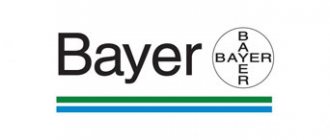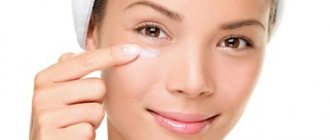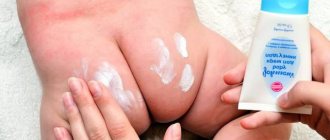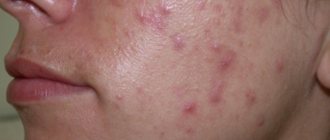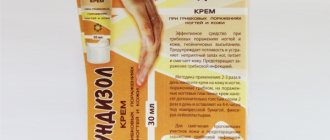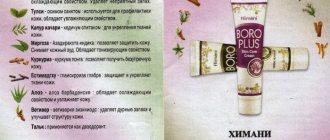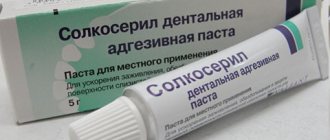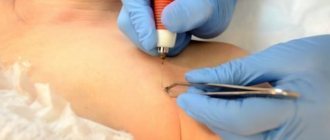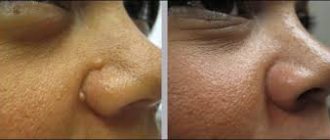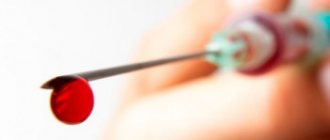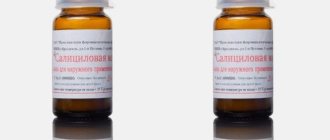Composition and release form
Under the trade name Baneocin, a combination of antibacterial drugs Bacitracin + Neomycin is produced in two dosage forms - in the form of powder and ointment.
The powder contains sterile corn starch as a base, which mixes well with antibiotics. This ensures flowability and uniform distribution of particles throughout the entire volume of the powder, which is one of the quality indicators. The powder is placed in a plastic package with holes, like a salt shaker. The packaging ensures contactless application of the drug to the site of skin damage.
Another dosage form - Baneocin ointment, in addition to a combination of antibiotics, contains lanolin and white soft paraffin. This base is well distributed on the skin and ensures the penetration of the main components into the layers of the skin due to its lipophilicity.
You can read about why fatty bases are preferable for the skin in this article.
Baneocin is not a hormonal drug , but, nevertheless, it cannot be used for a long time and here's why. A few words should be said about the antibiotics themselves.
Bacitracin is an antibiotic of a polypeptide nature exclusively for external use. Little has been written about its systemic effects, as well as its toxicity when released into the systemic circulation. For this reason, all official sources warn against its long-term use (more than 7 days) and against application to large areas and wounds that occupy more than 1% of the total surface of the skin.
For comparison, 1% of the area of human skin is approximately equal to the area of one palm. Which already makes it not very safe. And I would not use it on children from the 1st day of life, as written in the instructions, or on pregnant and lactating women with extensive wounds. The manufacturer does not have sufficient information on this matter; in addition, the expected benefits do not justify the potential harm; there are safer drugs.
The second reason not to use this drug for a long time and over large areas is the aminoglycoside antibiotic Neomycin. It must be said that the group of aminoglycosides is one of the most toxic groups of antibiotics due to the presence of serious side effects, which include hearing loss and inhibition of hematopoiesis when they enter the bloodstream and exhibit systemic action.
This antibacterial substance is also not used systemically, only in local dosage forms, including ear drops, naturally in lower concentrations. In this case, the potential benefit outweighs the possible risk and the remedy is fully justified, but nevertheless, a doctor’s consultation is required before starting treatment.
These substances cover the spectrum of gram-positive and gram-negative microorganisms that cause suppuration of wounds, but they are not effective against viruses, fungi, anaerobic bacteria (which can cause inflammation in the deep layers of the skin where there is no access to oxygen) such as Clostridium, including the causative agent of tetanus, Pseudomonas aeruginosa rods, Bacteroides, etc.
Therefore, it is useless to use Baneocin both in the form of ointment and powder for:
- Uncomplicated herpes infection;
- Fungal infections of the skin and nails;
And also for allergic reactions such as hives, unless of course you scratched the skin until it bled with your nails and caused an infection, then it makes sense.
Baneocin, recommendations from dermatologists
The ointment and powder should be used according to the instructions, as they have a strong antibacterial effect. Baneocin treats the skin from various lesions: acne, blackheads, even purulent rashes. The drug should be used once a day, preferably in the evening.
The product is applied to the entire affected area, with the exception of small or rare occurrences of acne. In this case, a targeted effect is performed.
In the morning, you need to wash your face thoroughly and apply toner or moisturizer. Baneocin is recommended to be used for 1-2 weeks, then you should take a break.
To see results for acne, 2-3 applications are enough. After several treatments, the appearance of new pimples on the skin will stop, and the size of the old ones will decrease, even in heavily affected areas. By continuing to use Baneocin, you will see that there are no acne left on your skin at all.
When acne appears on your skin, do not despair. It is enough to apply Baneocin ointment or powder once a day before bed and in a very short period you will regain your former beauty.
How does Baneocin work?
This medicine is used to accelerate the healing of sores and increase the rate of regeneration of the skin with minor violations of their integrity.
These include:
- abrasions;
- Scratches;
- Burns;
- Minor cuts.
Among all wound healing agents, there are two groups with different mechanisms of action:
- the first group - products that have a direct regenerating effect (These include Methyluracil, Solcoseryl, Actovegin, Aloe.);
- the second group - agents that have an indirect regenerating effect. These substances increase the speed and reduce the healing time of wounds due to the fact that they suppress the development of pathogenic microorganisms at the site of injury. (And as you know, a wound that is cleared of microbes heals much faster.) These include all antibacterial drugs and antiseptics.
This medicine belongs to the second group of healing agents. For this reason, there is no point in applying it to already protracted and healed abrasions, scars, post-acne and age spots.
The advantages, of course, are that:
- Microbial resistance to the antibiotics Bacitracin and Neomycin individually develops very slowly, and when they are combined, the risk of developing resistance tends to zero;
- Both antibiotics are highly soluble in water, and our plasma consists of 90% water, so a large concentration is created at the site of application, which is destructive for microbes.
This is the reason for the high effectiveness of the drug.
Description and properties
A combined pharmaceutical preparation with antibacterial activity is intended for external therapy. It contains 2 substances - bacitracin and neomycin, which enhance the therapeutic effect of each other, providing a complex effect. "Baneocin" is active against many pathogenic microorganisms and fungi, and also acts in the fight against infectious and inflammatory diseases of the epidermis.
The medicine acts quickly and when using it, you don’t have to worry that addiction will develop, which means that Baneocin will be highly effective even with long-term use. The maximum concentration of the main substances is observed directly in the application area, which allows you to quickly destroy infectious agents, stop inflammatory processes and restore the skin.
Using Baneocin externally, its components are practically not absorbed into the general bloodstream and do not penetrate into the depths of tissue structures, which means that side symptoms during therapy with it are extremely rare.
Application
Baneocin can be applied:
- On the face, avoiding the eyes and area around the eyes;
- Skin on the scalp and other parts of the body (groin area and armpits);
- Damaged skin.
The powder is sprinkled directly onto the site of the skin injury. If there is heavy superficial bleeding, you must first treat the area with hydrogen peroxide. It is recommended to keep the wound dry and not wet, so as not to aggravate the wound process. This way the damage will heal faster.
Baneocin ointment is applied in a sufficient amount under a breathable gauze bandage or a breathable patch with a backing 2-3 times a day, more often it is not recommended.
It is NOT recommended to apply this product to the mucous membranes of the mouth, nose, and genital organs due to the high likelihood of developing undesirable effects, because the drug is absorbed faster and in larger quantities through the mucous membranes.
Recommendations from dermatologists for the use of baneocin
Baneocin ointment is a strong antibacterial drug, so it should be used with caution, following the instructions.
The drug helps in the treatment of acne, pimples, as well as rashes on the face, especially purulent ones. It is recommended to apply the ointment once a day, in the evening. If there are only a few pimples, the ointment is applied pointwise to each of them. If the affected area is large, you need to treat the entire affected area. In the morning, you need to wash your face and wipe with tonic. The maximum period for daily use of baneocin is from a week to two, after which you need to take a break from use.
Basically, 2-3 treatments are enough to remove pimples and acne. The condition of even severely acne-affected skin improves: they decrease in size and then heal completely.
Long-term (more than 2 weeks) use of the ointment without medical supervision is not recommended. A course of treatment is possible. So, acne is a problem for many, especially young people and girls, which distorts appearance and brings a lot of problems to life. They are especially dangerous for people who are very sensitive to their appearance, since the problem lies primarily on a psychological level.
But don’t despair, because now there are a lot of drugs that will help you quickly and effortlessly get rid of unpleasant manifestations on the skin. It is enough to lubricate the affected areas of the skin with Baneocin ointment before going to bed, especially since the reviews about the product are very informative.
Indications for use
According to official instructions, clinical and cosmetological practice, Baneocin is used:
- For cuts and cracks in the skin;
- For open, fresh, shallow wounds after bleeding has stopped;
- For trophic ulcers, eczema and other skin diseases, with secondary bacterial infection;
- When complicated by herpes infection infected with microorganisms and chicken pox;
- Bacterial diaper dermatitis and prevention of umbilical infection;
- For processing after circumcision;
- For disinfecting skin after tattoos and piercings;
- As one of the means of choice for weeping wounds, including in the postoperative period;
- For processing seams;
- After cosmetic manipulations on the skin to prevent infection.
Contraindications
We have already partially touched on the contraindications of the drug Baneocin. To clearly understand in which cases this remedy should not be used, we will write again in more detail:
- Extensive damage to the skin, more than 1% of the total area of the skin;
- Deep wounds;
- Extensive trophic ulcers (due to the large area of ulcers and the limited time of use of this drug - usually trophic ulcers require longer treatment than 7 days);
- People who have lost their hearing;
- People who have problems with the nervous system or have lost hearing as a result of taking medications, including antibiotics;
- Cannot be used for subcutaneous and intradermal inflammations, especially with dense contents: boils, carbuncles;
- Baneocin creates the concentration in the skin necessary to destroy microbes, but does not have osmotic activity and does not penetrate deeply through intact skin, which is also a limitation for use. Contrary to official instructions. This product is able to penetrate into the deep layers of the skin and reach the systemic bloodstream only when directly applied to an open wound.
The following categories of people should use it with caution and after consulting a doctor:
- Pregnant and lactating women;
- To old people;
- Infants, children under one year old due to the high resorptiveness (permeability) of the skin;
- People using blood thinners;
- Also use with caution on chemical burns.
Comprehensive acne treatment
When acne appears, it is necessary not only to use Baneocin ointment, but also to treat the problem from the inside. To do this, the following steps are required:
- Proper nutrition. Fried and fatty foods should be excluded. More vitamins, mineral water, fermented milk products.
- Rejection of bad habits. You need to quit smoking, then your body will get rid of toxins, which will help your skin take on a natural look.
- Healthy sleep. To maintain good skin condition, you need a rested and full of energy body.
- Hygiene. It is imperative to take care of your skin, regularly cleanse, moisturize, and apply Baneocin ointment to the affected areas.
And finally, I would like to note that a healthy lifestyle is the key to your success. Play sports, don’t be nervous, walk, take care of yourself and then skin problems will never bother you!
Side effects
Side effects of the drug Baneocin are caused by the antibiotics it contains. As a local remedy it can cause:
- Irritation and itching;
- Allergic reactions.
If a large amount of the drug enters the systemic circulation, more serious complications can occur: problems with hearing, the nervous system, and those that have not yet been described. As written above, the systemic effects of the antibiotics included in the drug Baneocin have not been thoroughly studied , so do not experiment.
What to choose Baneocin powder or ointment?
When deciding which form of the drug Baneocin to choose: powder or ointment, you should take into account the nature of the skin lesions for which it will be used.
I recommend remembering the rule: apply powder to wet wounds.
Baneocin powder should be applied to all wounds, cracks, cuts and burns from which ichor comes out, as well as weeping trophic ulcers, weeping eczema.
The ichor - a transparent sticky liquid flowing from a wound - is an excellent breeding ground for pathogenic microbes, but when it dries, a protective crust is formed that protects the site of damage to the epidermis from infection. The powder absorbs moisture, thus having a drying and antibacterial effect, which overall will speed up healing.
The second reason why powder, rather than ointment, should be applied to weeping wounds is that when moisture is released, the ointment, which has a fatty base, is washed out of the wound (as we know, oil does not mix with water), and, therefore, the effectiveness of the drug decreases.
Therefore, Baneocin ointment should be applied to:
- Dry wounds;
- Acne;
- Non-wetting burns;
- Rosacea complicated by bacterial infection;
- Atopic dermatitis and seborrhea complicated by bacterial infection, accompanied by dryness and flaking of the skin;
- Helps heal cat scratches well.
Lanolin in the ointment has a softening effect, however, after the sore has healed in the absence of inflammation, it is recommended to use products with a regenerating effect, such as Methyluracil and Solcoseryl.
Baneocin ointment for acne on the face, back and other parts of the body shows good results because it contains antibacterial substances with exactly the spectrum of antimicrobial activity that is needed, including Streptococci, Staphylococci and acne-causing bacteria.
How to use
Before using the product, you must consult your doctor, since baneocin is an antibiotic and can lead to unpleasant consequences if its use is contraindicated. You need to consult a dermatologist or cosmetologist, who will not only check for restrictions on the use of the product, but also tell you how to use it correctly in your case.
Before applying the drug, you need to cleanse the skin without using soap, which, in combination with the antiseptic property of baneocin, can dry out the skin too much. You can wipe your face with an alcohol-free cleansing lotion or toner, then remove any remaining moisture with a clean towel or napkin. The powder or ointment should be applied to the affected areas before going to bed, and in the morning you will need to wash off the remaining product with a tonic.
If acne is mild, there are few pimples and they are located at a distance from each other, it is recommended to apply powder or ointment locally so as not to dry out healthy skin. If large areas of skin are affected, baneocin is applied to the entire face in a thin layer. If necessary, in combination with the drug, you can use a moisturizer suitable for your skin type so as not to dry it out.
The drug must be used daily, the duration of the course is determined by the doctor individually in each case. For some, 3-4 applications are enough to get rid of mild to moderate acne, while others will need longer exposure. However, we should not forget that baneocin contains two strong antibiotics, so its use should not last longer than two weeks. If during this time you cannot get rid of the entire problem, you need to take a break and then repeat the course again.
It should be borne in mind that to completely get rid of skin imperfections, external influence alone will not be enough. Despite the fact that baneocin for acne is quite effective, it will need to be supported by following a diet, rationalizing your daily routine, giving up bad habits, etc. Only in this case can you count on a lasting positive result.
Similar means
The drug baneocin has two dosage forms: powder and ointment. Therefore, we will consider each analogue separately.
Analogues of Baneocin powder
Of course, the first cheap Russian analogue of this dosage form is Streptocide powder.
Streptocide
Streptocide is a sulfonamide antibiotic with a wide spectrum of activity, but is not intended for application to wounds with a large amount of pus (you can read about this on our forum). Although this remedy copes well with fresh and weeping wounds, including burns, trophic ulcers, damage to the epidermis after tattoos and piercings. If you make a choice between Baneocin and Streptocide, you should remember that with long-term use Streptocide has less severe side effects and is also active against anaerobic bacteria.
The cost is from 20 to 50 rubles for a 2 gram bag and about 150 rubles for a 10 gram package.
"Ambulance" powder for wounds
This product does not contain antibiotics and has a more natural composition, which includes:
- Talc (drying, moisture-retaining agent);
- Potato starch (filler, base component);
- Zinc oxide (has anti-inflammatory, drying, anti-allergic effect);
- Powder of the rhizomes of Calamus (has anti-inflammatory, astringent and antiseptic effects, the latter of course inferior to antibacterial drugs);
- Salicylic acid powder (has a drying, keratolytic effect).
In the instructions for this powder for wounds, the effect of the components is far-fetched; such a composition will naturally be inferior to drugs with antibiotics and, if there is an infection in the sore, it simply will not cope.
The only indications for which I would definitely recommend using this remedy are weeping with atopic dermatitis, not complicated by a secondary infection, and weeping, uninfected eczema to absorb moisture and dry out damaged skin in this area.
Dermacide
The next analogue in powder form, Dermacid, is a veterinary drug, but has a very good composition.
The dermacide contains the following components:
- Xeroform (an antiseptic bactericidal substance, also included in Vishnevsky ointment);
- Streptocide is a sulfonamide antibiotic;
- Tannins (have anti-inflammatory and astringent effects).
As we see, all these components are also used in humans in dosage forms, so this analogue is also suitable for treating various damage to the epidermis.
Dermatsid's indications include:
- Treatment of wounds;
- Treatment of postoperative sutures;
- Treatment of the area after castration (in animals);
- Treatment of trophic ulcers.
The price varies depending on the packaging size, which ranges from 10 to 200 grams.
Ranosan
Another drug also belongs to the veterinary category - Ranosan.
Ranosan has the following composition:
- Chloramphenicol (an antibiotic better known as Levomycetin);
- Methyluracil (powerful healing agent);
- Lidocaine hydrochloride (an anesthetic that relieves pain and sensitivity at the site of skin damage);
- Zinc oxide (anti-inflammatory, drying anti-allergenic agent);
- Potato starch (excipient, base).
We are also seeing all of the components being used in human dosage forms as well. The first two components are the main active ingredients of Levomekol ointment.
This drug can be used to treat:
- Wounds and cracks;
- Trophic ulcers;
- Complicated eczema.
Due to the presence of Lidocaine in the composition, this drug should not be used by people who have convulsions, including on Lidocaine, suffering from various forms of atrioventricular heart block, or heart failure.
The price of Ranosan is about 160 rubles per 5 gram jar.
You should know that veterinary drugs, especially those applied to wounds, are also subject to strict requirements, so there is no doubt about their effectiveness and safety, especially since these drugs contain components used in drugs for humans. But we should also not forget about possible side effects caused by the components included in the composition.
Analogs of Baneocin ointment
Among ointment analogues, first of all, it is worth mentioning ointments containing the broad-spectrum antibiotic Chloramphenicol - these are drugs such as Levomekol, Levomethyl and Sinthomycin liniment. A separate article has been written about each of these drugs and we recommend that you take a closer look at them.
All these drugs are used to treat various damage to the epidermis, including in surgical practice.
If you are in doubt about whether to choose Baneocin or Levomekol, it is better to consult a doctor, because in a particular case one or the other drug will be preferable.
This product is certainly cheaper than Baneocin ointment itself. So the price of Levomekoli is approximately 150 rubles, Levosin is approximately 100 rubles, Sintomycin liniment is approximately 70 rubles.
Argosulfan
The next drug that can replace Baneocin is Argosulfan ointment. Its main active components are Silver ions and a sulfonamide antibiotic.
The ointment is suitable for processing:
- Wounds, abrasions and skin cracks;
- Burns;
- Trophic ulcers and eczema.
The price is about 350 rubles for 15 grams and about 600 for a 40 gram tube.
Oflomelid
Another analogue, Oflomelid ointment, is also used for various skin lesions, including wounds, trophic ulcers, acne and purulent-inflammatory skin diseases.
The ointment contains:
- Ofloxacin (broad spectrum antibiotic);
- Methyluracil (healing agent);
- Lidocaine (local anesthetic).
The ointment is applied under a breathable bandage or loosely if the wound area is small.
The price is about 180 rubles per 30 grams.
Vishnevsky ointment
Also, Vishnevsky-style balsamic liniment can rightfully be considered an analogue of Baneocin ointment and many antiseptic and antimicrobial agents.
This product with a unique composition is widely used for the treatment and cleansing of infected wounds, burns, for the healing of trophic ulcers and the treatment of other skin damage.
You can read about how to properly use Vishnevsky ointment in this article.
The price of the ointment is about 40 rubles per 40 gram tube, apparently it is a cheaper analogue of Baneocin.
Betadine ointment
The main active ingredient is the antiseptic Povidone-iodine. It is the active form of iodine, but is less irritating to the skin than regular iodine. It is used for burns, trophic ulcers, and various skin lesions.
Also available in solution form.
The price of the ointment is about 250 rubles for a 20 gram tube, the price of the solution is about 150 rubles for 30 ml and about 350 rubles for 120 ml.
Analogs of Baneocin in the form of other dosage forms
Let's look at similar products that have a different dosage form, but have similar effectiveness.
Fukortsin
Fukortsin solution is a powerful antiseptic and, like Baneocin, can be used to treat wounds, abrasions, and fungal infections. However, the use of Fukortsin has limitations due to the active acids in its composition: they can dry out the skin or leave a chemical burn.
The price is about 20 rubles per 10 ml bottle.
Olazol
The drug Olazol is presented in the form of an aerosol, which ensures its contactless application to the site of injury.
Its main components are:
- Sea buckthorn oil, which has a healing effect;
- Levomycetin is a broad-spectrum antibiotic;
- Benzocaine is a substance that reduces pain sensitivity;
- Boric acid is an antiseptic and drying agent.
The aerosol form is convenient for treating burn surfaces, seams and cracks, but if there is a need for the drug to remain on the wound for a long time, then pay attention to ointments containing Chloramphenicol, which we wrote about above.
The price is about 150 rubles.
Gel Prontosan
It contains an antiseptic and is recommended for use in surgical and cosmetology practice, for the treatment of sutures and wounds.
The price is approximately 600 rubles.
Reviews
We invite you to read the reviews about the drug Baneocin that we encountered on various information sites. If you still have any questions, you can always ask a question on our forum, and we will be happy to help you!
I constantly use Baneocin for cuts and burns, an excellent remedy that speeds up healing. Once I fell off my bike and scratched my elbow on the asphalt, went to the pharmacy and asked for streptocide, but there was none and the pharmacist advised me to buy this product. And not in vain, the sore literally healed before our eyes. Now I always have it in my closet in case of any damage to the skin.
Victoria, 27 years old
The wound did not heal for a long time, I would peel off the crust myself, or it would get caught somewhere, the doctor advised me to buy Baneocin ointment and apply it under the bandage at night. I started using it and my injury healed very quickly. However, this product has a huge disadvantage - it is very expensive, so you have to use it sparingly.
Victor, 34 years old
